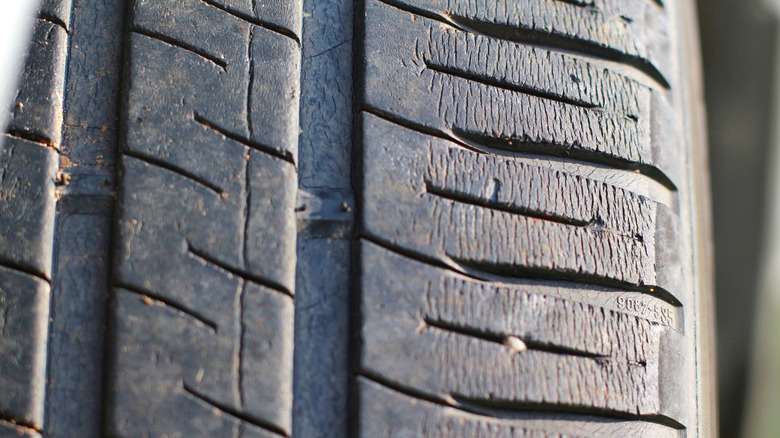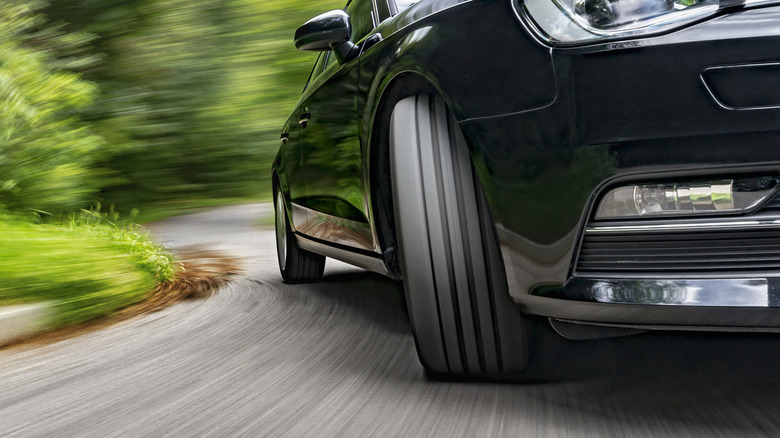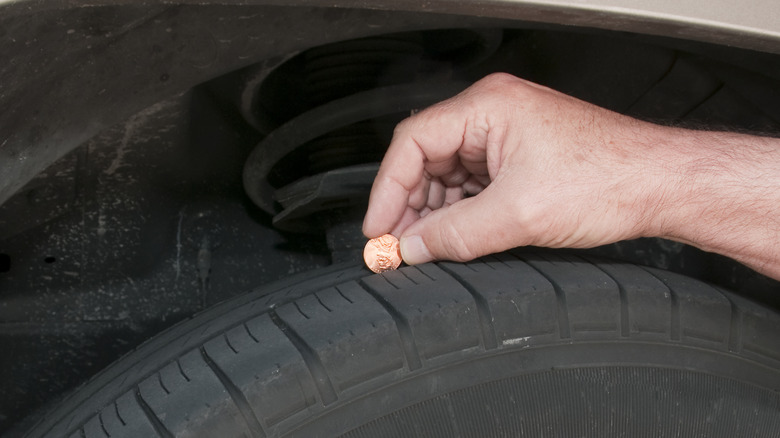What Are Wear Bars On Tires? (And How To Read Them)
With so many parts of your car in need of consistent upkeep, it can be easy to forget to check your tires. However, it's an oversight that could lead to serious consequences. According to the National Highway Traffic Safety Administration (NHTSA), there were over 560 fatalities from car crashes involving tire issues in 2022. This alone should encourage you to consider replacing your tires when the need arises. When your tires are new, your vehicle gets better traction. This also means it becomes more responsive to steering and braking inputs, which improves your overall safety.
But when exactly should you replace your tires? You can opt to change your car tires in pairs or all at once earlier than necessary, but in doing so, you won't fully maximize their performance. Plus, it's harmful to the environment — these still-good tires end up in landfills, adding to the 400 million tires dumped there every year. Instead of second-guessing, there's a built-in feature in your tires that could readily tell you the precise time to replace them. This feature is called the wear bar/wear indicator.
Tire wear bars, explained
Tire wear bars (also known as tire wear indicators) are rubber bars on the grooves between the tire's treads, raised at 2/32nds of an inch. They're found at certain even intervals around the tire and typically look like little bridges connecting one tire tread to another. For many tire makes and models, they're fairly easy to spot. But some manufacturers add some sort of marker (like an embossed Michelin Man on the edge of Michelin tires) to make the location of the wear bars even more obvious.
Design-wise, most major tire brands use typical bars for the wear indicator, but you can also find other tires with less conventional styles. For instance, some Cooper tires use what's called the Wear Square indicator — a literal square on the tire whose sides gradually disappear until you're left with an exclamation point. Some Continental tires, on the other hand, have the QuickView Indicators — the letters D, W, and S (meaning, Dry, Wet, and Snow), each of which fades away over time.
As the name suggests, tire wear bars are designed as visual indicators to tell you how much your tires' treads have worn down. New tires usually have 9/32nds to 11/32nds of an inch of tread depth, and as per tire experts, they're still good for use even at 6/32nds of an inch. However, once it reaches 2/32nds of an inch, exactly where the tire wear bars are at, they are due for a much-needed replacement as recommended by many manufacturers. You're also legally obligated to do so in the United States as 2/32nds of an inch is the shallowest allowable tread depth in many states.
Why you should care about the tire wear bars
Understanding the premise behind the tire wear bars is important, because if you're unsure whether or not your tires are still safe to use, you can put yourself and others at risk on the road. The treads on your car's tires work to push water, snow, or even mud away from your tires. They aim to keep your tires in maximum road contact as consistently as possible, allowing you to control your car better, especially when driving through wet or snowy roads.
Being made of rubber compound, tire treads don't last forever (unless, of course, you don't use the car at all). When the treads become thinner over time, their grip on the road is significantly reduced, causing you to lose control easily. You'll also notice a drop in the car's braking power, which can compromise your safety. That's why the tire wear bar matters — it's the key to knowing when to take your car in for a tire replacement.
How to check your tire wear
Reading the typical tire wear bars is easy. All you need to do is park on a flat road, turn any of your tires outwards to better see the treads, and then look for the raised rubber in the grooves. Then, check if any of the treads are already at the same level as the bar next to it. If that's the case, it's time to get new tires. But what about for uneven wear when some sections are still higher than the tire wear bar? The same rule applies. As long as one tread is already flushed with the bar, you need to replace the tire. You don't have to wait for all the treads on your tire to wear down to 2/32 of an inch.
On some tires, like Goodyear's Assurance MaxLife, the wear bars come with levels like 8, 6, 4, 2, indicating the tread depths 8/32, 6/32, 4/32, and 2/32 of an inch for better monitoring. Once you see that it's at 2, get the tires replaced. If, however, you don't see any horizontal bars on your tire's grooves, the manufacturer may be using a different wear indicator style. Refer to the tire maker's guide to see what this style is and how to read it.
Alternatives to the tire wear bars
The wear bars on tires are meant to be a built-in indictor of wear. However, if you somehow can't find the wear bars on your tire or you're not sure what kind of wear indictor your tire uses, there are other ways to estimate the tread depth on your tire using external tools. One such tool is a U.S. penny. First, inspect your tire for the groove that looks most worn out. Put the penny upside down (with Lincoln's head down on the tire) in your chosen groove. Then, check whether you can still see the top of his head. If not, your tread is still deep enough. If yes, you're due for a tire replacement.
If your tire treads are still way above the wear bars and you want to know how much depth you still have, another must-have tool is a tread depth gauge. This can provide you with a more accurate measurement, and it's pretty easy to use. Just place the end of the gauge (the needle part that extends) on the groove and the base of the gauge on the top of the tread. Then, read the measurement where the scale stops at the top of the gauge.
Tips and tricks to prevent your tires from early or irregular wear out
Tire treads are expected to wear out sooner or later, depending on how you use your car. But there are certain habits that slash the life out of your tire faster. If you want to keep your tires from losing tread too soon, one of the tips and tricks to keep in mind is to properly inflate them. When a tire doesn't have the right pressure, the treads don't come in contact with the road evenly, leading to more wear on some sections. At least once a month, measure the pressure of all your tires and see if they're inflated according to your car manufacturer's instructions. It's also a good idea to check the tire pressure when carrying heavier loads than usual or before taking your car on a distance drive.
Aside from tire pressure, wheel alignment is also a factor contributing to uneven wear on your tires. Your vehicle should be following the manufacturer's alignment specifications — otherwise, you'll end up with irregular-looking treads. To check the wheel alignment, visit your local auto repair shop. Another habit to practice is swapping your tires around every 6,000 to 8,000 miles, especially if you're driving a front-wheel drive (FWD) vehicle. This is because the car's front tires endure more forces like steering and braking inputs and engine load. So to make sure all four of your tires wear evenly, rotate the front and rear ones at proper intervals.





